PinotFile: 8.2 October 3, 2009
|
Pisoni Vineyard: Pinot Noir from Heaven
Back label of Tantara Pisoni Vineyard Pinot Noir
The Santa Lucia Highlands of California’s Monterey County lie in what is often called “Steinbeck Country,” referencing the celebrated twentieth century writer John Steinbeck. His novel, Grapes of Wrath, was published in 1939 and won both a Pulitzer Prize and Nobel Price, and has become one of the most widely read and discussed novels on college campuses throughout the United States. The title of the novel is an indirect reference to a passage in the Bible (Revelation 14:19-20) that speaks to deliverance from oppression. Steinbeck noted that the Santa Lucia Highlands “was like Heaven.” Others have tabbed it Eternidad Paraiso or eternal paradise. In 1982, Gary Pisoni, realizing that the Santa Lucia Highlands provide a heavenly setting for Pinot Noir, planted six acres of vines in virgin, well-drained, decomposed granite and sandy loam soil on his father’s 280-acre cattle ranch. He was not the first to plant vinifera grapes in the Santa Lucia Highlands. The planting of wine grapes dates to the 1790s when Spanish missionaries arrived, while the modern era of winegrowing began with the plantings of Rich and Claudia Smith at Paraiso, Micky Hahn at Smith & Hook, the McFarland family at Sleepy Hollow, and Phil Johnson at La Estancia.
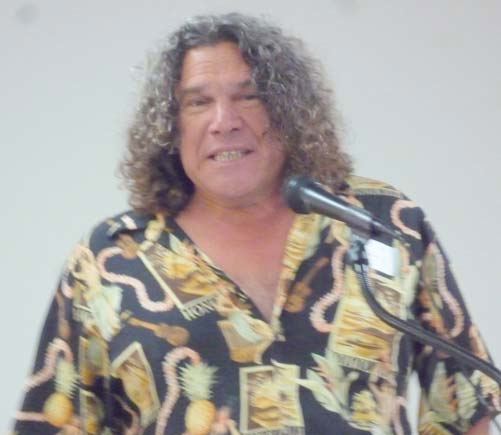 Gary (photo right) had come from generations of farmers who tended row crops long before he was born. Jane and Eddie Pisoni, Gary’s parents, had started farming vegetables in the Salinas Valley in 1946. Gary developed an interest in French wines while in college, reading any books he could find about Pinot Noir and studying Burgundy. When he graduated, he headed for Europe where he had his wine epiphany with a Burgundy from Domaine de la Romanee-Conti. Upon returning to the states, he was eager to find a way into the wine business. When he told his father he wanted to plant grapevines on the family cattle ranch, he was met with several objections, not the least of which was the cost. Gary countered to his father, “Have you ever been to a $250 lettuce tasting?” His father relented and a famous vineyard was born. The original planting, located at 1,300 feet above the Salinas Valley at the southern end of the Santa Lucia Highlands AVA, consisted of Cabernet Sauvignon, Cabernet Franc, Merlot, Chardonnay and Pinot Noir. The vines were originally irrigated with water trucks. It took ten years of witches and well drillers to tap into springs that the American Indians valued for their healing qualities and the Spanish used to irrigate their vineyards. Once a water source was located, an additional 40 acres of Pinot Noir were planted in several blocks ranging in size from .5 acre to 16.8 acres with different trellising and vine spacing, using both own-rooted and grafted vines. The plantings on the hillsides are known as Big Block, Susan’s, Old Vineyard and Elias blocks. The blocks located in small valleys are Mommy’s, Hermanos, Camper, Mario and Tina. The different blocks have distinct soils and microclimates but all benefit from the fog and afternoon breezes that curls in from nearby Monterey Bay contributing to the area’s cool mornings and nights. The own-rooted Elias Block, consisting of 4.5 acres planted in 1995, is used for the estate Pisoni Pinot Noir that is known to Pinot geeks as “Pisoni-Pisoni,” differentiating it from Pisoni vineyard-designated bottlings from other California producers. The Mommy’s and Camper blocks are also own-rooted. Gary Pisoni believes own-rooted vines make more flavorful Pinot Noir. The source of the Pinot Noir scion material in the Pisoni Vineyard is subject to much speculation. At least some of the cuttings have been long rumored to originate as “suitcase selections” from the La Tâche Vineyard in Vosne-Romanee (Gary will not admit to this), but other reports locate the source as a vineyard in Monterey County. In any case, the Pinot Noir plantings have become known as the Pisoni clone or selection. Gary’s winemaker son, Jeff Pisoni, and viticulturist son, Mark Pisoni, created the Pisoni label, releasing the first estate Pinot Noir in 1998. A second label, Lucia, meaning “light,” debuted in 2000. The Lucia label includes Chardonnay, Syrah, Cabernet Sauvignon and Rosé, as well as Pinot Noir. Some of the grapes for Lucia wines are sourced from the Pisoni Vineyard, some are designated Garys’ Vineyard, and some are a blend of both vineyards. The Lucia wines spend less time in barrel, are raised in less new oak and are vinified with less whole cluster than the Pisoni Estate Pinot Noir, and are accordingly priced less.
The Pisoni family, Gary and Gary’s sons, Jeff and Mark, own and farm Pisoni Vineyard, and in partnership with Gary Franscioni, Garys’ Vineyard. Garys’ Vineyard is located eight miles north of Pisoni Vineyard in a somewhat cooler area, and was planted in 1997. Gary Pisoni and Gary Franscioni were school mates and lifelong close buddies. Garys’ Vineyard is 50- acres in size, with 42 acres planted to Pinot Noir with cuttings from the Pisoni Vineyard. Franscioni also owns Rosella’s Vineyard nearby, named after his wife. Rosella’s is planted to Pisoni selection, Pommard, and Dijon clones of Pinot Noir. These three vineyards are among the most sought-after contractual vineyards in California. In 2008, the Franscioni and Pisoni families began planting the Soberanes Vineyard, located in the heart of the Santa Lucia Highlands and owned by the Bianchi family. When Gary Pisoni stepped into winegrowing in 1982, the growers in the Santa Lucia Highlands often reached for high tonnage and sold their wine in bulk to other counties. Gary Pisoni took another tack, one that had begun to show promise at the time at Chalone, Calera and Sanford. He emphasized meticulous farming, looking for quality rather than quantity. The Pisoni’s have since become famous for their uncompromising grape farming. Vineyard mangager Mark Pisoni has a B.S. in Agricultural Economics from the University California Davis and a Master’s Degree in Farm Business Management from Cornell University. He directs the activities of both the Pisoni vegetable farm and vineyards. Most of their 15-person vineyard crew have been with the Pisonis for years including vineyard supervisor Mario Reyes Angel, now a veteran of over 15 years at the Pisoni Vineyard. Dozens of passes are made through the vineyard each growing season, with workers sculpting the vines through shoot removal and positioning, fruit thinning, green fruit dropping and leaf pulling. The resulting Pinot Noir fruit is among the most highly prized in California.
 Jeff Pisoni (photo right), an enology graduate of California State University Fresno, took over the winemaking for the Pisoni and Lucia labels in 2002. Before that, the Pisoni Estate Pinot Noir was crafted at off site wineries initially by Marc Aubert and subsequently by Vanessa Wong. Michael Zardo, a graduate of California State University Fresno, is currently the assistant winemaker at Pisoni Vineyards and has been with Pisoni since 2003. The Pisoni family have had their own winery since 2007. Winemaking is traditional. Whole cluster inclusion will vary depending on the development of stems, tannin maturity and other factors reflected by the vintage. A 2 to 5 day cold soak is followed by fermentation in small open-top stainless steel bins with hand punch downs. Fermentation is driven by both natural and inoculated yeast. Press wine is usually not included in the finished wine. Aging is carried out in roughly 65% new French oak barrels for approximately 16 months. The wine is bottled unfined and unfiltered. Pisoni Vineyard is located in the warmer southern portion of the Santa Lucia Highlands. The resulting Pisoni Estate Pinot Noirs are known for their opulent and lush dark fruit (plum, blackberry, blueberry, black cherry), spice and earth-inspired flavors. They are remarkably distinctive and exemplary of the New World or Caliesque style of Pinot Noir. Wine retailer Paul Root said it best in one of his humorous 2004 newsletters (perhaps a bit exaggerated but to the point nonetheless). “The common theme that weaves its way through the Santa Lucia Highlands efforts is this: Nearly all we’ve tasted have been hugely extracted, powerfully fruity, and muscular, yet balanced and intensely flavored. Colors range from deep purple-blue to pitch black. They are near cloying in their viscosity and weight, and most importantly, they are a KICK to drink. An experienced, Burgundy-loving ‘Franco-File’ would either be utterly awestruck at the dimension of these wines or simply pass out in a foggy blur when pressed to compare them with their precious ‘terroir’-infused, obscenely priced, ‘Cote de Frou-Frou’ dust-covered jars in their ‘cauve’ back home.” To put it another way, these are not Pinot Noirs in high heels and ruffles, but rather well-muscled wines in combat boots with spiked hair. Gary Pisoni did more than just establish a “grand cru” vineyard in the Santa Lucia Highlands. His boundless energy brought notoriety to the region to the point that the Santa Lucia Highlands has become known as “Pisoni country.” Many top producers of Pinot Noir in California craft a Pisoni Vineyard Pinot Noir including Arcadian, Capiaux, Lorca, Miura, Patz & Hall, Peter Michael, Roar, Ryan Cellars, Siduri, Tantara and Testarossa. Beginning in 2008, Paul Lato has been added to the roster. Older vintages include wine produced by Ojai Vineyards, Roessler, and Tandem. Pisoni Vineyard is considered one of the top ten Pinot Noir vineyards in California, joining Hirsch Vineyard (Sonoma Coast), Fiddlestix Vineyard (Sta. Rita Hills), Sea Smoke Vineyard (Sta. Rita Hills), Clos Pepe Vineyard (Sta. Rita Hills), Bien Nacido Vineyard (Santa Maria Valley), Jensen Vineyard (Calera), Mount Eden Vineyard (Santa Cruz Mountains), Hanzell Vineyard (Sonoma Valley), Rochioli Vineyard (Russian River Valley), Summa Vineyard (Sonoma Coast) and Savoy Vineyard (Anderson Valley) on the elite list of most honored Pinot Noir vineyards. I recently sampled Pisoni Vineyard Pinot Noirs from the 2005 and 2006 vintages. The wines were very impressive for their consistent high quality, regardless of producer. It is safe to say that the name “Pisoni Vineyard” on a bottle of Pinot Noir is a guarantee that the wine inside will be stellar. I have never been so struck by the high quality of the Pinot Noirs produced by multiple vintners from the same vineyard. The Pisoni Vineyard Pinot Noirs are not for the faint of heart. They are bold expressions of Pinot Noir - Pinot Noir in combat boots with tattoos and spiked hair, not Pinot Noir in high heels and ruffles. They will stand up to any robust fare such as game and a big slab of beef, and they will offer immense pleasure to those drinkers who appreciate an expansive wine of great charm. The wines can be counted upon to age, with a window of excellent drinking lasting a decade or more. The wines don’t come cheap, but a Pisoni Vineyard Pinot Noir will never disappoint.
 2006 Capiaux Pisoni Vineyard Santa Lucia Highlands Pinot Noir 14.6% alc., $46. · Very fruity nose replete with black cherries and blackberries with a hint of savory herbs and spice. The dark fruits cascade over the palate in waves with an appealing silkiness. The tannins are supple, the oak is faint and supportive, and the whole package is on target. Nicely crafted. Score: 91
2006 Siduri Pisoni Vineyard Santa Lucia Highlands Pinot Noir 14.1% alc., $48. · An oak-inspired wine that has beautiful fruit. Aromas of black cherries, sage and oak. Full-bodied flavors of blackberries and black cherries with noticeable oak in the background. A robust, structured wine with delicious fruit, moderate tannins and a dry finish. Oak lovers will relish this wine. Score: 88
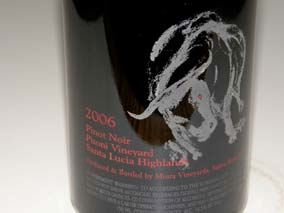 2006 Miura Pisoni Vineyard Santa Lucia Highlands Pinot Noir 14.5% alc., $50. · A striking nose of intense black berry bombast. Rich and lush on the palate, drinking like a Cabernet with full-bodied and tantalizing black cherry and black berry fruit, a touch of red licorice and green tea, and some lemon peel in the background. Minimal tannin, silky in texture and quite sophisticated in presentation. Score: 89
2006 Tantara Pisoni Vineyard Santa Lucia Highlands Pinot Noir 14.6% alc., $60. · The black cherry fruit scents really jump out of the glass augmented by aromas of vanilla and brioche. Very tasty and intense dark cherry and berry fruit flavors with an earthy undertone. Soft and smooth on the palate with supple tannins, noticeable absence of oak, and a dry, lengthy, fruity finish. Thoroughly enjoyable and highly recommended. Score: 91
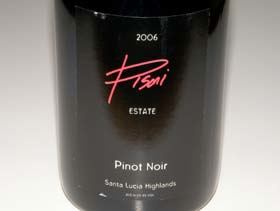 2006 Pisoni Estate Santa Lucia Highlands Pinot Noir 14.5% alc., $65. · Very attractive aromas of dark stone fruits and black raspberries. Earth-kissed dark Pinot fruits with a grilled meat tone offer an unmistakable sense of terroir. Ample acidity, moderate dry tannins and a very smooth and harmonious mouth feel. Still somewhat subdued and demure, this impressive wine will benefit from more cellaring. Score: 93
2005 Capiaux Pisoni Vineyard Santa Lucia Highlands Pinot Noir 14.7% alc., $46. · Darkly fruited nose with a generous dose of oak. Big and intense with mouth coating dark fruits, moderate fine-grain tannins and a lemon peel note on the finish. Like all the 2005 vintage Pinot Noirs from Capiaux, the oak supersedes the fruit. Score: 87
2005 Arcadian Pisoni Vineyard Santa Lucia Highlands Pinot Noir 13.8% alc., $60. · Lightest in color of all the Pisoni bottlings. Appealing aromas of black cherries, spice, straw, herbs and a touch of barnyard. Tasty black cherry, blueberry fruit with a tangy finish. Very soft dry tannins. This is a very Burgundian interpretation of the Pisoni Vineyard, more austere than all the other Pisoni Vineyard bottlings, with an appeal that sneaks up on you. Score: 89
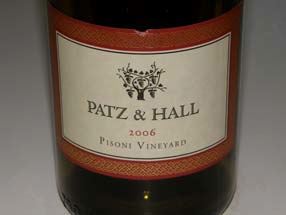 2005 Patz & Hall Pisoni Vineyard Santa Lucia Highlands Pinot Noir 14.6% alc., $65. · Noticeably lighter in color than most of the other Pisoni Vineyard wines. Attractive scents of brambly cherries, sage, herbs and faint oak. The flavor emphasis is on dark red berries with an underpinning of savory herbs. Smooth and relatively light in weight with soft tannins. This wine represents the more sensual, elegant side of Pisoni Vineyard and is quite enjoyable. Score: 90
2005 Pisoni Estate Santa Lucia Highlands Pinot Noir 14.3% alc., $65. · Very dense reddish-purple color. Initially the nose is brooding but with coaxing some attractive scents of black fruits, exotic spice, anise, earth and toast emerge. A huge wine of immense fruit structure with healthy tannins to match. Flavors of blackberries, black raspberries, and rare beef. This wine assaults you with fruit but retains a harmonious appeal. Will stand up to any robust fare including a big hunk of game or beef. For Pinot Noir hedonists only. Score: 90
2005 Peter Michael Winery ‘Le Moulin Rouge’ Pisoni Vineyard Santa Lucia Highlands Pinot Noir 14.5% alc., $130 (secondary market). · Very attractive nuanced nose with scents of black cherries, red plums, wild sage, exotic spices and woods. A stunning wine of incredibly flavor intensity yet smooth and caressing. A perfect example of “iron fist in a velvet glove.” Dark cherry, berry, plum flavors with a hint of citrus and refreshing acidity on the persistent finish. A complete wine with great purity of fruit. The most expensive of the Pisoni Vineyard bottlings, the hardest to get your hands on due to its tight allocation, but worth a search and every penny. One of the greatest California Pinot Noirs I have drank in 2009. Score: 95
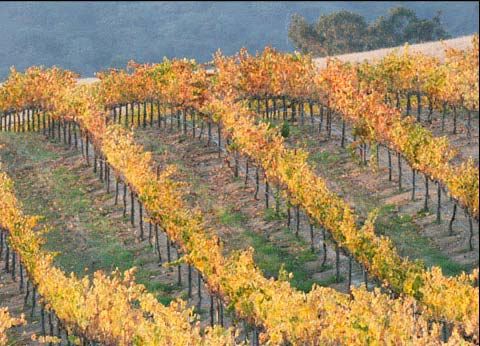 Pisoni Vineyards and Winery does not have a tasting room and does not provide vineyard visits. The mailing address is PO Box 908, Gonzales, CA 93926. The phone is 800-270-2525 and the website is www.pisonivineyards.com. Pisoni Estate Pinot Noir is sold only through a mailing list. Lucia wines are available through a mailing list with some restaurant and retail distribution. The Lucia phone is 800-946-3130 and the website is www.luciavineyards.com.
Olivet Lane Pinot Noir: Best Ever in 2007Olivet Lane Vineyard is one of California’s most cherished heritage Pinot Noir plantings. Owner Bob Pellegrini, who has been involved with wine in one way or another his entire life, reflects on the early 1970s and his decision to plant a vineyard on West Olivet Lane in the Russian River Valley, and says, “I was just naive enough at the time to think it would work, but if I knew then what I know today, I would never have done it.” Ignorance can sometimes turn out to be bliss and today Pinot Noir lovers are the grateful beneficiaries of Bob’s fortitudinous decision. The Pellegrinis are Sonoma County wine patriarchs who started the Pellegrini Wine Company after the repeal of Prohibition in 1933, and began shipping grapes from Sonoma County and making wines for San Francisco’s best restaurants. The family later became wholesale distributors of imported and domestic wines. In 1973, Vincent Pellegrini approached Paul Mononi about buying his 65-acre prune, apple and olive orchard on a spur off of Olivet Road named West Olivet Lane. The land was in an area of the Russian River Valley now known as Laguna Ridges. Paul Mononi had grown up on the property his father acquired in 1955. He sold the property to Vincent and agreed to plant a vineyard for him. Vincent’s son, Bob, was fresh out of school, had just returned from a tour of Burgundy and was intrigued by the idea of planting Pinot Noir on the newly acquired land. At the recommendation of Dr. A.N. Kasimatis of University California Davis, both Pinot Noir and Chardonnay were planted beginning in 1975. Economic considerations came into play in the decision to plant both Chardonnay and Pinot Noir as Chardonnay was much more in demand than Pinot Noir at the time, with Pinot Noir only bringing $325 a ton. Pinot Noir clones were difficult to source in 1975. Paul recalls, “Clones were not of any importance, you had to beg for vines, and you had no positive assurance that you were receiving Pinot Noir clones.” The Olivet Lane Vineyard was planted to what is now called the Martini clone (UCD 13 and 15), sourced from field selections grown at the Stanly Ranch Vineyard in Carneros farmed by Louis M. Martini and Harold Olmo. The Olivet Lane Vineyard was one of the first Pinot Noir plantings in the Russian River Valley, preceded a few years by only a handful of others including the Bacigalupi Vineyard (on Westside Road in the Middle Reach in 1964), Rochioli Vineyard (East Block planted in 1968, also on Westside Road), and Joseph Swan’s vineyard (first planted in 1969 in the Laguna Ridges and now named the Trenton Estate Vineyard). The Olivet Lane Vineyard was uniquely planted to both Pinot Noir and Chardonnay. The 34-year-old vineyard is essentially a monoblock of Martini clone planted on AXR rootstock with wide vine spacing that was in favor during the 1970s. Because of the AXR rootstock, the Olivet Lane Vineyard is susceptible to phylloxera and some blocks have shown phylloxera-induced decline by reduced yields. Portions of the vineyard are being incrementally replanted using the Martini clone budwood from the remaining original vines to retain the vineyard’s unique character. Currently, the vineyard is planted to two-thirds Chardonnay and one-third Pinot Noir. The photos below were shot at the Olivet Lane Vineyard just before the 2009 harvest.
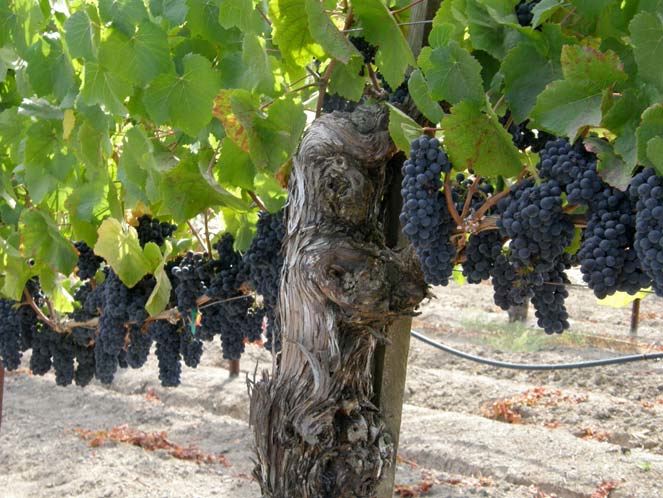
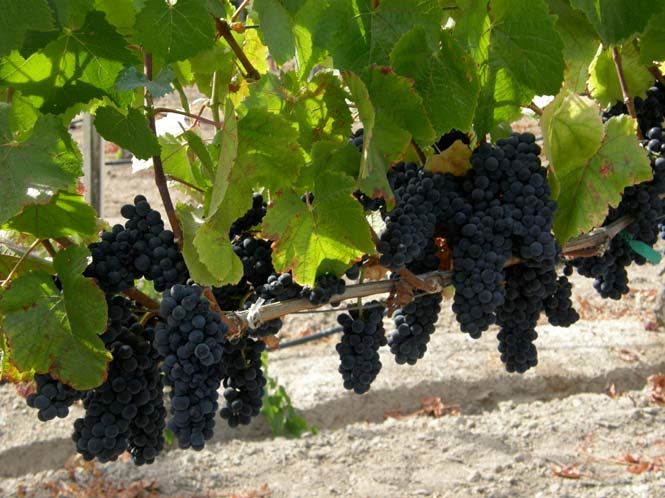 Winemaker Kevin Hamel talks about the distinctive terroir of the vineyard that is reflected in the wines. The Olivet Lane Vineyard is unique for its red fruit, fragrance and subtle spice and floral notes. The grapes have a near perfect balance at harvest, developing desirable flavors at 24.0º to 24.5º Brix with spot-on acidity. As a result, the wines from this vineyard are never blockbuster wines, and need only a judicious touch of oak to compliment the delicate flavors of the grapes. Trials have been ongoing over the last few vintages comparing indigenous yeast and inoculated yeast fermentations for both the vineyard’s Chardonnay and Pinot Noir. The lots undergoing indigenous fermentation have consistently shown more complexity and interest. Beginning in 2006, a reserve Olivet Lane Estate Pinot Noir was produced, largely composed of native fermented lots which have undergone additional barrel aging. The 2007 regular Olivet Lane Estate Pinot Noir is about 25% native fermented and the 2007 Olivet Lane Estate Reserve Cuvée is 75% native fermented. Beginning with the 2008 vintage, fermentations will be almost exclusively native. The Pellegrinis began producing an Olivet Lane Pinot Noir in the 1980s. Over the years, grapes were sold to Brogan Cellars, Gary Farrell, Kosta Browne, Merry Edwards, Williams Selyem and WesMar wineries. Today, Merry Edwards is the only producer receiving significant amounts of fruit, the rest being retained for the Olivet Lane Estate Pinot Noir annual production of 2,500 to 3,000 cases. The Olivet Lane Vineyard wines are sold primarily through the tasting room, retail wine stores and restaurants. The wines are also available online at www.pellegrinisonoma.com. A Tuscan-styled winery and tasting room were built on the Olivet Lane Vineyard property in 2001 at 4055 West Olivet Road in Santa Rosa. The tasting room is often open, but phone ahead (800-891-0244).
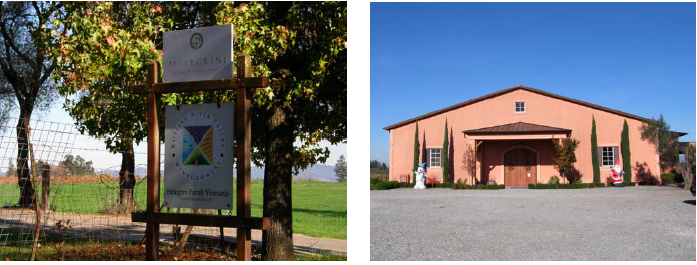
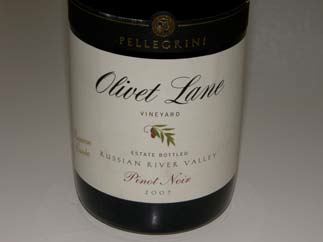 2007 Olivet Lane Vineyard Estate Reserve Cuvée Russian River Valley Pinot Noir 14.1% alc., 168 cases, to be released in 2010. Packaged in a heavier, taller bottle which makes a statement. More new oak aging than the regular Estate bottling. · This is a more decadent version of the estate wine. The fruit intensity is ramped up on the nose offering a melange of dark red cherries and berries with a hint of spice and a subtle floral scent. Delicious red plum and black cherry flavors expand in the mouth, showing a mild firmness, density and chewiness, yet still retaining a silky sensuality. A very polished wine that is beautifully crafted and approachable now although patience will bring even more rewards. Definitely worth the reserve designation and the best Olivet Lane Vineyard Estate bottling to date. Score: 92
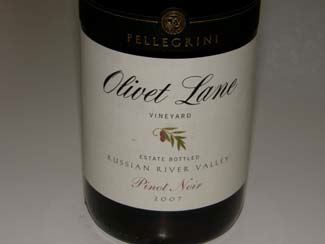 2007 Olivet Lane Vineyard Pellegrini Family Vineyards Russian River Valley Estate Pinot Noir 14.1% alc., pH 3.48, 2,600 cases, $35, now released. Aged 16 months in 33% new French oak, mainly Francois Freres and Rousseau. · Moderately deep reddish-purple robe. Intoxicating nose right out of the bottle showing off bright Bing cherry, a hint of strawberry jam on toast and the faintest oak. The enticing medium-bodied core of red fruits are touched with citric peel and sweet oak. The wine flows like silk over the palate, offering vim and vigor from the refreshing acidity. Soft tannins make for easy current drinkability, but this can age. Score: 90
Benovia Winery: Hidden GemHeading west on bumpy Piner Ranch Road in Santa Rosa, a driver must remain alert not to miss a turn off on Hartman Road, a single paved lane that travels through acres of vineyards. There is no indication that you are eventually going to dead end at Benovia Winery. Upon arrival, however, a new entrance signifies the recent emergence of Benovia Winery and you will be quickly enamored with the excellence of the wines. With only two vintages in release, Benovia is still a secret to many avid pinoaficionados.
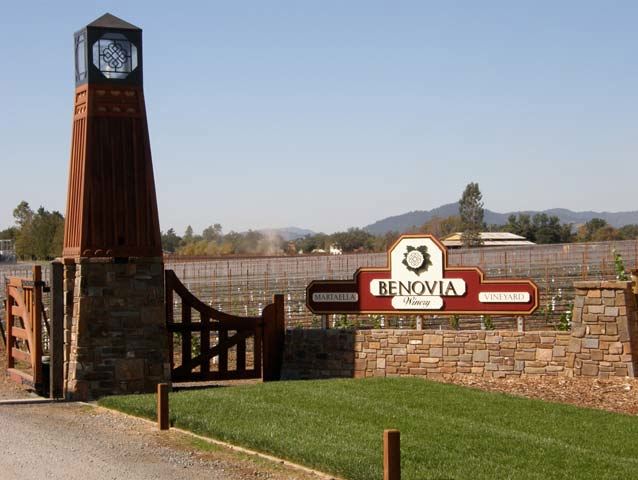 Benovia Winery is a well-funded venture spearheaded by a group of businesspersons headed by Joe Anderson, whose Arizona company, Schaller Anderson, Inc., is a successful third-party administrator for health insurance. Joe has a passion for fine wine and has committed significant resources to producing extraordinary wines. The winery manager is Bob Mosby, PhD, a psychologist and business consultant who formerly lived in Phoenix, Arizona. Bob is a long time wine enthusiast who first worked crush at Williams Selyem in 1989 and in later years at Brogan Cellars. The veteran winemaker is Michael Sullivan, a graduate of California State University of Fresno who previously gained a reputation for refined Pinot Noirs at the Hartford Family Winery in Forestville (Photo below shows Michael, the Benovia forklift butt, weighing incoming grapes at this year’s harvest). The vineyards are managed by well-known viticulturist Daniel Roberts, PhD (“Dr. Dirt”), who is overseeing renovation of existing estate vineyard properties including the Martaella Vineyard adjacent the winery, and directing all new planting projects.
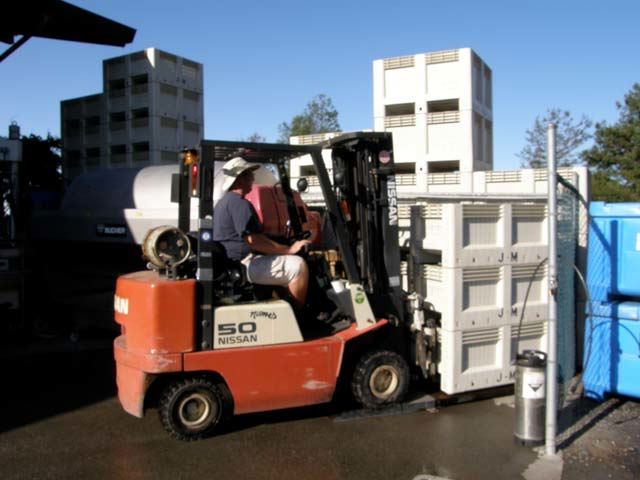 Benovia Winery is the owner of the Cohn Vineyard from which it produces a vineyard-designate Pinot Noir. The Cohn Vineyard was planted in 1975 to Martini 13 and Pommard clones and was in neglect when acquired in 2005. Extensive work has resurrected this heritage vineyard. Another vineyard-designate Pinot Noir is sourced from the Savoy Vineyard in Anderson Valley. The winery’s Sonoma Coast blend is sourced from estate vineyards and family growers in the Russian River Valley and Sonoma Coast. The Bella Luna bottling represents a composite of all the sub-regions of the Russian River Valley (Green Valley, Middle Reach and Laguna de Santa Rosa). An estate property near Freestone is currently undergoing development. In addition to Pinot Noir, Benovia Winery produces superb Chardonnay. Accounting for 25% of the winery’s production, Benovia Chardonnays are sourced from cold, coastal sites in the Russian River Valley and Sonoma Coast. A Zinfandel from the Cohn Vineyard completes the portfolio. The wines are sold through a mailing list at www.benoviawinery.com. Tours and tasting are available by appointment (707-526-4441). Inquire about small quantities of remaining 2007 vintage wines. A fall winery Open house will be held at the winery on November 7 from 11:00 AM to 3:00 PM, and an Open House at the Phoenix, Arizona home of Joe Anderson and Mary Dewane will be held November 15.
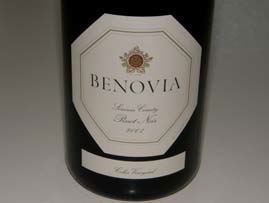 2007 Benovia Cohn Vineyard Sonoma County Pinot Noir A problematic vintage as a fire at the vineyard burned leaves and very little crop (0.38 tons per acre) ripened. · Moderately light garnet color. Alluring heady aromas of berry jam, spiced cherries, juicy fruit gum and a hint of oak. On the palate the flavors are exotic with slightly tart dark Pinot fruits, savory green herbs and a touch of sweet oak. Light on its feet with supple tannins and bright finishing acidity Score: 89
2007 Benovia Sonoma Coast Pinot Noir 14.3% alc., $45. Spring release (some availability in the retail market). · Bright, juicy and perfect for drinking now. Sublime melange of fresh-picked berries and cherries on the nose are echoed in the flavors. Slippery tannins and perky acidity makes this wine a perfect food partner. Score: 90
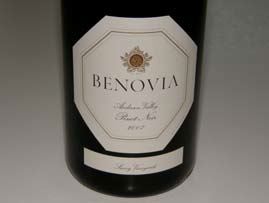 2007 Benovia Savoy Vineyard Anderson Valley Pinot Noir 14.1% alc., 352 cases, $55. Clones 113,115, Martini 13, Pommard and Calera. · This wine has the whole package. Bright aromas of black cherries, herbs and Provencal spice. Delicious core of cherries, raspberries and cranberries with a tasty touch of vanilla cream. Soft and sensual in the mouth with substantial but caressing tannins, a refreshing spark of acidity, and a ridiculously long aromatic finish. Still somewhat shy and will reward further patience. Plenty of Pinot singing. Score: 92
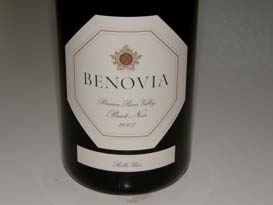 2007 Benovia Bella Luna Russian River Valley Pinot Noir 14.5% alc., 181 cases, $58. The name Bella means “beautiful together” and represents a special blend of several vineyards from the Russian River Valley. · Very charming nose of black raspberries, forest floor, wine cellar and a hint of smoke. Generous core of black cherries and black raspberries with a hint of citrus, framed by fine-grain tannins and offering a huge fruity finish. Still reserved and elusive, but approachable now. This one aims to please. Score: 90
Marsannay: Burg’s Bargain BinI am a collector and regular drinker of red Burgundy but I review the wines infrequently. Premier Cru and Grand Cru wines are just too precious to simply open and taste so I drink them only in the context of a fine meal or with special friends. In addition, there are a number of reviewers more adept than I with a highly respected voice about Burgundy such as Allen Meadows of the Burghound. In the last decade, and particularly since 2005, the price of fine Burgundy has skyrocketed. This trend has been fueled by a number of factors including the interest among deep-pocketed collectors in Burgundy (there are almost 400 billionaires in the United States), the extremely limited quantities of the top wines, the weak American dollar, and the names such as DRC, Dujac, Leroy and Rousseau taking on a luxury goods mantra. Red Burgundy has become the Cartier of the wine world and consumers have equated quality with desirability rather than the opposite. New York Wine importer, Neal Rosenthal, laments the current market for Burgundy. “The real tragedy of Burgundy was that a few prima donna domaines, most famously Romanee-Conti, had become so outlandishly expensive that the prices had become skewed. There was great irony there because in the past Burgundies were the best value wines on the market. They had more character, more integrity, and more flesh. There were $20 Burgs that iced everything else at the same price. They were the most underrated cheap wines on planet earth.” Burgundy is a vinous minefield with many wines simply not that great relative to price. The interested wine drinker must devote serious study to Burgundy, learning about vintages, producers, villages, and vineyards. The challenge then becomes locating the wine you want at a price you want to pay. The often-repeated joke applies here: “Fine Burgundy is wonderful if you can get someone else to pay for it.” How can the ordinary wine drinker find pleasure in the daunting world of red Burgundy? One approach is to look for the minor bottlings of the top wineries. Another tack is to seek out the best growers in the lesser known, less prestigious villages such as Marsannay-la-Côte. Marsannay crowns the Côte de Nuits, sitting above Gevrey Chambertain and just above Fixin, just south of Dijon. It has become known as the “Gateway to Burgundy.” Marsannay constantly struggles against urbanization from the populace in Dijon. Signs proclaiming, “Trop c’est Trop!” meaning, “Too Much is Too Much!” can be seen dotting the village.
 Once designated as Bourgogne, Marsannay was elevated in 1987 to its current village appellation contrôlée (AC) classification. It has struggled to escape its tawdry image dating to the first part of the nineteenth century when it supplied oceans of cheap Gamay Noir and rosé to the residents of nearby Dijon. Marsannay has 480 acres of vineyards, no premier crus, with several notable lieux-dits (named vineyards or climats) such as Les Champs-Perdix, Les Champs-Salomon, Le Clos de Jeu, Le Clos-du-Roi, Les Longeroies, Saint-Jacques, and Les Vaudenelles. There is a high percentage of old vines and many young, dedicated winegrowers, resulting in many quality value-priced wines. The terroir is not as highly regarded as say Gevrey Chambertain, but if you find a wine from a top grower in a good vintage, the result can be immensely satisfying. The commune is entitled to produce Marsannay rouge, Marsannay blanc, which usually made in a lean, Chablis style, and Marsannay rosé from Pinot Noir. Although northern in location, Marsannay is a mediumbodied sinewy wine. It is not as gutsy as it’s neighbor Fixin and does not display the finesse of Gevrey Chambertain. The wines are made for early enjoyment, although they can perform beautifully for at least five years after release. Bruno Clair is the most well-known Marsannay producer, but Domaine Sylvain Pataille, established in 2001, has brought glitter to the village. Pataille was a vineyard consultant for Roumier and Groffier before settling in his hometown. He is fanatical about meticulous farming, committed to biodynamic farming and even planted one of his vineyards from seed instead of cuttings or clones. Unfortunately, the one bottle of 2005 Sylvian Pataille Marsannay Clos du Roy I purchased was badly corked and I could not review it. I recently sampled a number of Marsannay wines from the outstanding 2005 and respectable 2006 and 2007 vintages. The wines of Bruno Clair clearly stood above the crowd. The lineup of wines was solid, although not exceptional, but delivered the Burgundy experience at an affordable price. The 2005 vintage wines were clearly superior. In some cases, the Marsannay wines offered more interest and personality that many California Pinot Noirs in the same $20 to $25 price range. However, some wines had foreboding tannins and acidity which needed food to mitigate. The wines do not provide the mid-palate fruit intensity and persistence on the finish of higher cru Burgundy wines. All things considered, the wines deserve a look if you are seeking Burgundy at a sensible price. The name, Marsannay, is easy to pronounce, the wines are widely available, and the tariff is easy to swallow. Prices range from $15 to $58 (for Denis Mortet Marsannay Les Longeroies).
2007 Domaine Bart Marsannay Rosé 12.5% alc., $13. Imported by Latitude Wines, Inc., Danville, CA. · Moderately deep pink coral color. Perfume of earthy red fruits and a mild roseate scent. Light in weight with crisp flavors of red raspberries and strawberries, marzipan and citrus peel finishing tart and dry. Score: 86
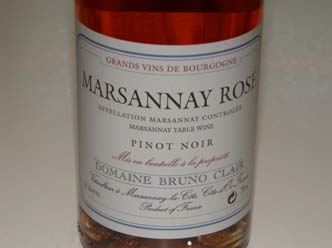 2007 Domaine Bruno Clair Marsannay Rosé 12.5% alc., $22. Imported by Vineyard Brands, Inc., Birmingham, AL. · Moderately deep rose color. Bright strawberries and peaches compose a vivid nose followed on the palate with richly flavored strawberries and a sidecar of cherry cola and orange peel. Dry and pleasing with some persistence on the finish. Impressive. Score: 87
2006 Domaine Bart Marsannay Les Finottes 12.5% alc., $21. Imported by Latitude Wines Inc., Danville, CA. · Intense dark fruits with plenty of fecundity on the nose. On the palate the underlying dilute black cherry and raspberry fruit is overtaken by pushy oak tannins. The finish ends with a lively spark of citrus tang. Score: 82
2006 Domaine Ballorin & F Marsannay Les Echezots 12.5% alc., $24. Imported by Fruit of the Vine Inc., NY, NY. · Subdued notes of cherries, strawberries and wildflower on the nose. Earthy and rustic flavors of berry preserves with noticeable oak in the background. Slightly sweet with a strong grip of acidity. Score: 85
2006 Domaine Collotte Marsannay Les Champ Salomon Vielles Vignes 13.0% alc., $27.50. A Peter Weygandt and Burgundy Wine Co. Selection. · Expressive nose of spiced berries, forest floor, wet cement and oak. Light-weighted dark red fruits with refreshing acidity. The flamboyant tannins are imposing at present. Score: 86
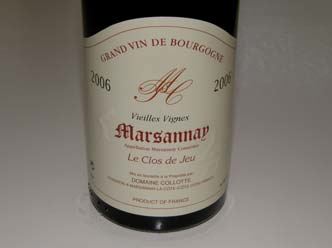 2006 Domaine Collotte Marsannay Le Clos de Jeu Vielles Vignes 13.0% alc., $28.50. A Peter Weygandt Selection. · Slightly confected aroma of warm berry tart. Tart flavors of dry cherries and cranberries with an underpinning of grapefruit. On the light side with plenty of acidity, drying tannins, and sweet oak in the background. Score: 86
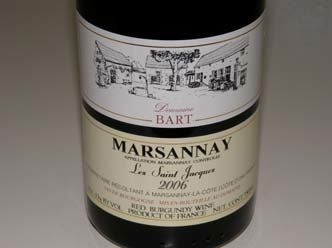 2006 Domaine Bart Marsannay Les Saint Jacques 13.0% alc., $30. Imported by Latitude Wines, Inc., Danville, CA. · A fruity nose composed of black cherries, raspberries and strawberries. Moderate in weight with loamy dark red fruits that are smooth and polished in the mouth. The tannins are reigned in and there is admirable fruity persistence on the finish. Nicely composed and well worth the tab. Score: 87
2005 Domaine Louis Jadot Marsannay 13.0% alc., $20. Imported by Kobrand Corp, NY, NY. · Subdued but pleasant perfume of black cherries and sandalwood. Tart and crisp black cherry flavors with a notable citrus tug, plenty of acidity and supporting oak in the background. Score: 85
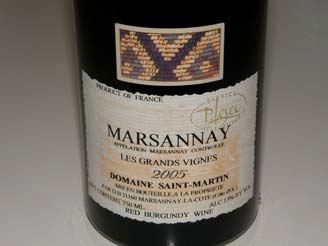 2005 Domaine Saint-Martin Marsannay Les Grands Vignes 13.0% alc., $20. Imported by Wine Warehouse, Los Angeles, CA, a Patrick Le Sec Selection. The proprietor is Martin Bart, whose father started the domaine in 1955. · Dark reddish-purple color. Dark plum, dark chocolate and oak char on the nose. Thick black and blue fruits tasting of mu shu plum sauce, citrus, mineral and marzipan. Big and intense, with some tannin to shed. Plenty of wine for $20. Score: 87
 12.0% alc., 8,000 cases, $20. Sourced from 25- to 30-year-old vines including ones in Les Longeroies and Clos du Roy, aged 12 months in a combination of 2- and 3-year-old French oak barrels and stainless steel. Imported by Louis Latour, Inc., San Rafael, CA. · Reddish robe. Scents of wild berries, violets, oak toast and stem. Tasty strawberry, cranberry and pomegranate core with an underpinning of earthiness and a grapefruit peel tang on the notably acidic finish. Mild dry tannins make for easy approachability. Score: 85
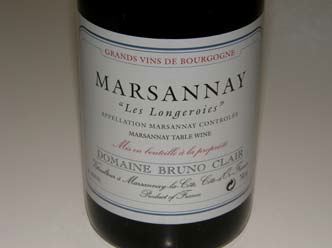 2005 Domaine Bruno Clair Marsannay Les Longeroies 13.0% alc., $24. Imported by Vineyard Brands Inc., Birmingham, AL. A David Hass Selection. · Lovely cherry and berry fruit that is pure and tasty with an appealing restraint. The acidity is subdued, the texture is velvety, the tannins are in harmony and the whole package is thoroughly charming. Highly recommended. Score: 89
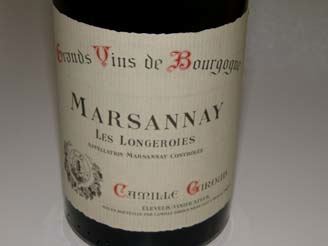 2005 Camille Giroud Marsannay Les Longeroies 12.5% alc., $25. Imported by Veritas Imports, Beverly Hills, CA, a Becky Wasserman and Burgundy Wine Company Selection. · Delicate and charming featuring raspberry, dried cherry and pomegranate fruits that slip lightly over the palate. Very smooth and delicate: a Grace Kelly of a wine. The most approachable wine of the several in this lineup and still drinking fine the next day from a previously opened re-corked bottle. I like it for what it is. Score: 87
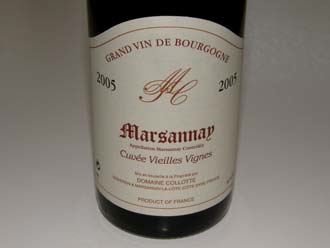 2005 Domaine Collotte Marsannay Cuvée Vielles Vignes 12.0% alc., $27. Imported by Weygandt-Metzler, Unionville, PA, a Peter Weygandt Selection. Unfiltered. · Very dark plum color. Very appealing thick nose of raspberries, wooded forest, leather, warm brioche and char. A robust sweet core of black raspberry fruit with a taste of citric peel on the tangy finish which lingers. Velvety texture with substantial tannins. Should age nicely. Recommended. Score: 88
2005 Geantet-Pansiot Marsannay “Champs Perdrix” 12.5% alc., $30. Imported by Kysek Pere et Fils, Ltd., Winchester, VA. · Very slightly corked. Aromas of berries and green garden lead to a rich and delicious core of raspberries. Great purity of fruit with tannins, acids and oak working together harmoniously. Impressive material and balance in spite of the very slight cork taint.
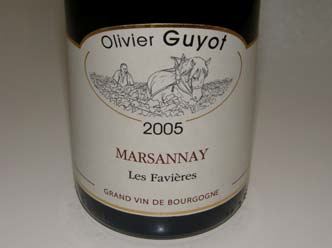 2005 Olivier Guyot Marsannay Les Favieres 12.0% alc., $30. Imported by Michael Skurnick Wines,Syosett, NY, a Michael Skurnick Selection. · Moderately dark reddish-purple color. Aromas of fresh strawberries, black cherries and mushrooms draw you in. Bright medium weighted dark berry core framed by soft tannins with lively acidity on the earthy finish. Score: 87
Other producers of Marsannay worth seeking out include Domaine Roty, Fougeray de Beauclair, Domaine Phillipe Charlopin-Parizot, Denis Mortet, and Charles Audoin.
Pinot Briefs
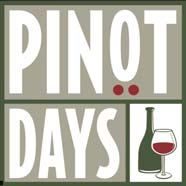 Pinot Days Chicago Tickets are now available for Pinot Days Chicago at the Navy Pier, November 13-14, 2009. Featured events include the Winemakers Table Hop Dinner at Bin 36 Restaurant on Friday, November 13 attended by ten producers, and the 3rd Annual Pinot Days Chicago Grand Festival Trade and Public Tasting on Saturday, November 14. The Grand Tasting will feature over 60 producers of Pinot Noir from California and Oregon. This is the only major Pinot Noir event held in the Midwest. For more information, a list of the participating wineries, and to buy tickets, visit www.pinotdays.com.
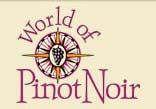 Tenth Anniversary of World of Pinot Noir Ticket sales begin October 1, 2009, for the 2010 World of Pinot Noir to be held at The Cliffs Resort, Shell Beach, California, March 5-6. This is full-on Pinot immersion for Pinot geeks including two days of in-depth Tasting Seminars, Pinot-By-The-Sea Grand Tastings with over 150 Pinot Noir producers, a Featured Burgundian Tasting with Allen Meadows and guest Jean- Marie Fourrier of Domaine Fourrier in Gevrey-Chambertain, two Gala Pinot Noir Dinners featuring famous chefs Roy Yamaguchi of Roys of Hawaii and Budi Kazali of the Ballard Inn, and culminating in a Santa Barbara style Paulée. This event always sells out quickly. Visit www.wopn.com after October 1 for tickets. Video: Crush Bret Lyman has written and produced a video for Don Sebastiani & Sons depicting harvest and grape processing at the company winery in Oakville. Very professional with beautiful photography and a nicely flowing story line. About 13 minutes in length. Check it out at www.vimeo.com/1033826.
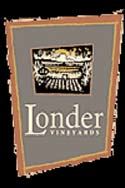 Londer Vineyards Opens Tasting Room I will miss the tasting sessions with Larry and Shirlee Londer in the kitchen of their home, but they have opened a new tasting room at 14051 Hwy. 128 in downtown Boonville in the Anderson Valley. Situated in a new art gallery, the tasting room will be open Thursday through Monday, 11:00 to 5:00. The gallery focuses on Southwestern art - a good fit, since Larry and Shirlee Londer hail from Albuquerque, New Mexico. If you visit, pick up some of Shirlee’s outstanding homemade jams. Londer Vineyards is the fourth winery tasting room in the town of Boonville, joining Foursight Wines, Zina Hyde Cunningham and Phillips Hill Estates. Visit the Londer Vineyards website at www.londervineyards.com for more details. Early Oregon 2009 Harvest Report Climatologist Dr. Greg Jones of Southern Oregon University in Ashland, Oregon has published a preliminary harvest report. In summary, Oregon experienced a relatively dry, cold winter and early spring followed by a mostly warmer and drier than normal May through September. The healthy crop is plentiful with ripe, tight, and larger than normal clusters. The short to long term forecasts indicate above normal temperatures and below normal rainfall for the remainder of September and October.
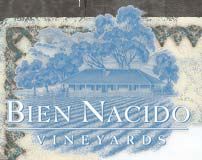 New Website for Bien Nacido Vineyards Nicholas Miller alerted me to the new website for Bien Nacido Vineyards. Visit the updated, informative and wellorganized website that now offers extensive information on the history of the vineyards, the terroir, clonal selection, maps of the vineyards and a listing of producers accessing fruit from the Bien Nacido Vineyards which include Bien Nacido, French Camp and Solomon Hills. Match Made in Wine Heaven? Gino Gallo, the granddaughter of Julio Gallo, one of seven children, public face of E&J Gallo, and head winemaker at Gallo Family Vineyards, and Jean-Charles Boisset, the owner of DeLoach in Santa Rosa and President of U.S. Boisset Family Estates, tied the knot September 26, 2009, at the Fairmont Hotel in San Francisco. This union joins scions of Burgundy’s biggest winery with American’s largest winery.
Wine Scoring Begins in the PinotFileRobert Parker, Jr.’s 100-point wine scoring system, which became popular in 1983 and was adopted by the Wine Spectator in 1985, has been the guideline for consumers seeking to buy good wine. Over the years, there have been many other scoring systems developed. The UC Davis 20-point scale was introduced in 1959, but is extremely objective and does not differentiate between objective observation and subjective evaluation. Another 20-point system, the ASTAB, suffers from the same disadvantage. Hedonic scales are popular because they are quick and simply ask, “How do you like the wine?” An example would be the 10-point Bo Derek hedonic scale: 1-2 for dislike extremely, 3-4 for dislike slightly, 5-6 for neither like nor dislike, 7-8 for like slightly, and 9-10 for like extremely. International Wine Review once used a 13-point hedonic scale, but has abandoned it for the 100-point scoring system. Currently, every major United States-based wine critic, wine publication and internet review site uses the 100- point scale. Even Connoisseurs’ Guide to California Wine, translates their three puff or star rating system to the 100-point scale (three stars: 95-98, two stars: 91-94, one star: 87-90, no star: 86 or less). There are many misgivings about the 100-point system, one of which is that there is no measurable difference in say, a rating of 89, versus 90. Respected wine critics Steve Tanzer and Allen Meadows have stated publicly that they have some apprehension about the numerical scoring system, but they have no choice but to use it as their readers expect it and rely upon it. In reality, scoring a wine only matters to the person doing the scoring since we all have different tastes. That said, the wine drinking public has come to depend on scores in choosing wines of quality and have become used to having others tell them what is good. Consumers often pay little attention to descriptions of a wine, focusing instead directly on the wine’s score. To insure that the PinotFile is relevant in today’s wine marketplace and for many of my readers who prefer scores, I have started to use the 100-point scoring system beginning with this issue. My scores will reflect how the wine is drinking at the time of the review, not the wine’s potential in the future as I believe this cannot be predicted with any certainty. The rating system is as follows. 95-99: an exceptional and complete wine. 90-94: a wine of great charisma that is distinctive and well-crafted. 85-89: a highly drinkable, solid example of a type of wine perfect in the context of a good meal. 80-84: undistinguished but decent wine. 79 and below: flawed or a wine I would not buy or drink. The Pinot Geek Icon will continue to appear, signifying only the most transcendent Pinot Noirs that I personally would make an effort to seek out. The Pinot Value Icon signifies an appealing wine that represents a bargain at the wine’s retail price in relationship to the quality of the wine.
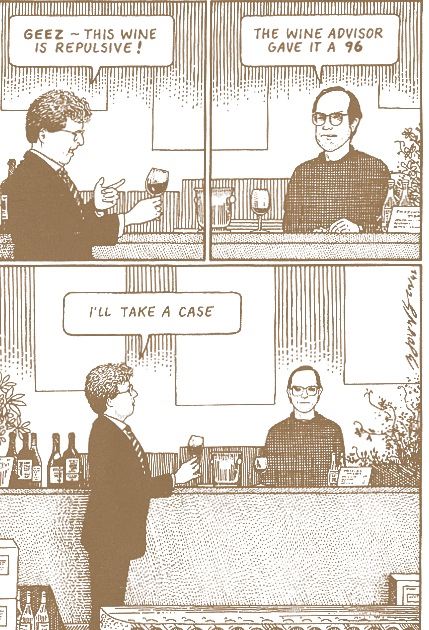 |